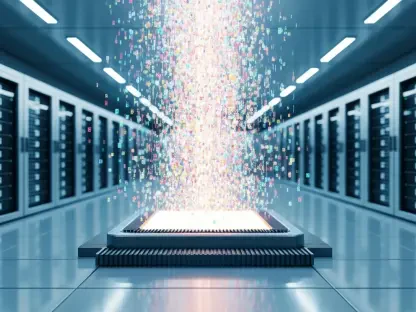In today’s fast-paced business landscape, where efficiency and innovation often determine success, companies are constantly seeking ways to streamline operations and stay ahead of competitors. Imagine a scenario where mundane, time-consuming tasks are handled seamlessly, errors are minimized, and employees can focus on creative, strategic initiatives that drive real value. This is no longer a distant vision but a tangible reality through the power of AI automation. Often referred to as intelligent automation, this technology merges traditional automation with artificial intelligence to create systems that not only perform repetitive tasks but also learn, adapt, and make informed decisions. For businesses, this represents an opportunity to tackle complex projects, enhance workflow efficiency, and build largely self-sufficient processes. The potential to transform operations and unlock significant growth is immense, making it a critical tool for modern enterprises aiming to thrive in a competitive market.
1. Exploring the Essence of AI Automation
AI automation stands at the intersection of conventional automation tools and cutting-edge artificial intelligence, offering a robust framework for handling intricate business challenges. Unlike traditional automation, which focuses on rule-based, repetitive tasks, AI automation introduces a layer of cognitive capability. This means systems can analyze vast amounts of data, learn from past interactions, and continuously improve their performance without constant human oversight. For companies, this translates to managing more sophisticated workflows with minimal intervention, allowing for scalability and adaptability in dynamic environments. The ability of these systems to mimic human decision-making processes ensures that even complex, nuanced tasks can be addressed with precision.
Beyond just efficiency, AI automation empowers businesses to redefine their operational models. By integrating intelligent systems, organizations can reduce the burden of manual processes and allocate human resources to areas that require creativity and critical thinking. This shift not only boosts productivity but also fosters an environment where innovation can flourish. As markets evolve and customer expectations rise, having such adaptable technology becomes a strategic asset. Businesses that harness this potential early stand to gain a significant edge, positioning themselves as leaders in their respective industries through smarter, data-driven operations.
2. Key Advantages of Implementing AI Automation
One of the most compelling benefits of AI automation lies in its capacity to save substantial time and effort for employees. Tasks that once took hours of manual labor can now be completed in minutes, thanks to automation tools. When AI is layered on top, with its ability to learn from new data and handle complex decision-making, the efficiency gains are exponential. This allows staff to redirect their focus toward higher-value activities that demand human insight and ingenuity. The result is a workforce that is not only more productive but also more engaged in meaningful work that contributes directly to business growth.
Additionally, AI automation significantly reduces the likelihood of errors in operational processes. When configured correctly, automated systems adhere to strict algorithms, outperforming human accuracy in repetitive tasks. They can process and analyze enormous datasets to inform decisions, minimizing mistakes that often arise from human oversight. Other advantages include the ability to identify untapped opportunities within existing data, enhance customer satisfaction through smarter service delivery, bolster security by swiftly addressing vulnerabilities, improve organizational agility to keep pace with market shifts, and drive innovation by accelerating research and development efforts. Each of these benefits contributes to a more resilient and competitive business model.
3. Core Technologies Powering AI Automation
At the heart of AI automation are several pivotal technologies that work in tandem to deliver intelligent solutions. Robotic Process Automation (RPA) serves as the foundation, handling repetitive, routine tasks such as data entry, payroll processing, or report generation. By automating these high-volume activities, RPA frees up more advanced AI components to focus on intricate decision-making. Meanwhile, overarching Artificial Intelligence capabilities mimic human cognition, enabling systems to learn from past actions, predict outcomes, and make informed choices. This is evident in applications like intelligent customer support routing or precise sales forecasting based on complex data analysis.
Further enhancing these systems are technologies like Machine Learning (ML) and its subset, Deep Learning, which allow automation tools to adapt and improve over time by recognizing patterns in data. Natural Language Processing (NLP) enables understanding and generation of human language, vital for chatbots and sentiment analysis. Generative AI pushes boundaries by creating original content, while Computer Vision interprets visual inputs for tasks like quality control. Intelligent Document Processing (IDP) streamlines document handling, and Business Process Management (BPM) optimizes workflows through detailed analysis and redesign. Together, these technologies create a powerful ecosystem that drives the efficiency and innovation of AI automation in business contexts.
4. Step-by-Step Guide to Implementing AI Automation
Implementing AI automation requires a structured approach to ensure seamless integration and long-term success. The first step is to identify opportunities where AI can make a significant impact. This involves scouting for processes that are inefficient, data-heavy, or involve complex decisions. By examining common bottlenecks, gathering input from teams on time-consuming tasks, or using process mining tools to map workflows, businesses can pinpoint areas ripe for improvement. Establishing clear priorities during this phase ensures that resources are allocated to the most pressing needs, setting a strong foundation for automation initiatives.
Once potential processes are identified, the next step is a detailed analysis to understand their current flow and challenges. This involves mapping out each stage, identifying pain points, and assessing whether AI automation offers a viable solution with measurable benefits. Following this, the design and development phase begins, where the smarter workflow is planned, and appropriate technologies are selected. Implementation then moves to launching and integrating the system with existing business tools to ensure smooth operation. Finally, continuous optimization is crucial, involving monitoring performance, updating AI models with fresh data, and incorporating human feedback to enhance accuracy. This iterative process ensures that the automation remains effective and relevant over time.
5. Real-World Applications of AI Automation in Business
AI automation offers a wide array of practical applications that can transform business operations across various functions. For instance, managing email communications becomes effortless as AI not only drafts responses but also acts as a central coordinator for shared inboxes like sales or support, ensuring timely and relevant interactions. Similarly, in sales, AI can research leads by pulling data from online sources, summarizing findings, and delivering actionable insights directly into CRM systems. This equips teams with critical information to prioritize high-potential prospects, enhancing conversion rates and efficiency.
Other impactful uses include adjusting manufacturing outputs based on real-time supply and demand data to prevent surpluses or shortages, and predicting maintenance needs for machinery by analyzing historical and current data to preempt breakdowns. AI also optimizes supply chains by factoring in sales trends and external variables, conducts rapid A/B testing for marketing assets, automates document processing for invoices or contracts, and even transforms creative ideas into production-ready code through automated reviews. Additionally, content creation is streamlined as generative AI drafts marketing materials or ad variations, allowing teams to refine rather than start from scratch. These examples illustrate the versatility and transformative potential of AI automation in everyday business scenarios.
6. Understanding the Distinction Between AI Automation and RPA
While both AI automation and Robotic Process Automation (RPA) aim to enhance efficiency, their capabilities and scope differ significantly. RPA focuses on automating repetitive, manual tasks through bots that follow predefined rules. A typical example is a bot categorizing users in a CRM based on subscription methods, executing straightforward, rule-based actions. This technology excels at reducing workload for routine processes but lacks the depth to handle tasks requiring judgment or adaptation beyond its programmed instructions.
In contrast, AI automation incorporates cognitive technologies such as machine learning and computer vision, enabling systems to learn from data and make nuanced decisions. For instance, it can analyze subscriber engagement metrics like clicks or bounce rates to suggest tailored content for future newsletters within a CRM. This added layer of intelligence allows AI automation to tackle complex, dynamic challenges that RPA cannot address alone. Understanding this distinction helps businesses choose the right tool for their needs, ensuring that automation efforts align with specific operational goals and deliver maximum impact.
7. Crafting a Strategic Approach to AI Automation
Launching an AI automation strategy demands careful planning and a phased approach to achieve sustainable results. The initial step involves securing support from top management by demonstrating how AI automation can deliver specific efficiency gains and measurable returns on investment. Following this, implementation should start gradually, focusing first on the most time-intensive tasks before expanding to less critical areas. Strong data governance practices must be prioritized to ensure the accuracy and security of data feeding AI systems, as poor data quality can undermine outcomes.
Subsequent steps include adopting an automation-first mindset, where tasks are evaluated for AI suitability before human assignment, and addressing ethical considerations like bias in decision-making or data privacy to maintain trust. Preparing the workforce through training ensures employees can effectively collaborate with AI tools, while documenting lessons learned from initial implementations helps refine future efforts. This strategic framework not only mitigates risks but also maximizes the value derived from AI automation, positioning businesses to adapt and innovate in an ever-evolving landscape.
8. Reflecting on the Path Forward with AI Automation
Looking back, the journey of integrating AI automation into business operations revealed a transformative toolset that redefined efficiency and innovation. Companies that embraced this technology tackled inefficiencies head-on, streamlined complex processes, and empowered their teams to focus on strategic priorities. The practical applications, from optimizing supply chains to enhancing customer interactions, demonstrated how AI automation adapted to diverse needs, delivering measurable improvements across industries.
Moving forward, the emphasis should be on continuous refinement and strategic expansion of these systems. Businesses are encouraged to invest in ongoing training for staff to keep pace with evolving tools, while regularly updating AI models with fresh data to maintain relevance. Exploring new areas for automation, guided by insights from initial implementations, can further drive growth. By fostering a culture of adaptability and ethical responsibility, organizations can ensure that AI automation remains a cornerstone of competitive advantage, paving the way for sustained success in a rapidly changing market.









